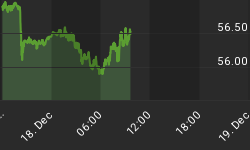The major market averages have been losing momentum and rolling over on short-term trends. Toppish patterns in the intermediate charts and a bearish head and shoulders top (Nov-Aug) in the DJIA, NASDAQ, FTSE, Wilshire 5000 and the TSX is coming into view, for instance, with the current downturn potentially completing the respective right shoulders (see Dow chart below).

Yet, a major divergence is showing in the speculative junior mining markets as represented below by GDXJ, the Junior Gold Miners index. As you can see the index has taken off from a July low near 26 and has worked itself up near 30.

This influx of buying into the sector is also shown by the increase in trading volume of the TSX-V (also known as the CDNX), the Canadian junior market as a whole. TSX-V volume rose dramatically from an early July low of near 1,200 and spiked to 2,500 a few days ago. It has since backed off but is still 50% higher than where it was in early July.

Other global averages have also been bucking the bearish trend including the Bombay Stock Exchange Sensex Index, the Dow Jones Chile Stock Index, the Argentina MerVal Index and the Shanghai Composite (chart below).

And so the question remains: Why is the Dow breaking down at a time when junior mining stocks and foreign markets are rebounding? It can't be falling earnings? The averages are priced at about 14 times "expected" earnings and earnings have been beating expectations last two quarters.
The trade cycle theory does not portend a downturn because real money supply growth rates (True Money Supply) have hardly begun to taper off (although there's a whole host of people working off the Fisher-Minsky debt-deflation formula and Keynes's theory of the business cycle led around by "aggregate demand").
It is true that the economy isn't going to return to a sustainable growth path with all this "stimulus" but when talking about market movements in the aggregate, the real economy isn't necessarily a determining factor. The bears argue that the credit contraction will worsen, lead to deflation and a 1930's style depression. But I am not buying this argument. I'm more inclined to think that this bear raid is going to be a bear trap - with the juniors giving away the bullish hand as the big funds load up on the sector of tomorrow.
What is most likely to happen, given the evidence the market is giving us, is that the weakness in the Dow will push the Fed off the fence at some point, especially going into the November elections in the US, compelling it to roll out the much anticipated QE v.2 to support the bond market. Or, at the very least, to scare the Fed out of thinking about tightening too soon. In the two charts below we see the equity put-call ratio closing on a buy signal while the index put-call ratio is going the other way, indicating the pros are more bullish than speculative traders. This supports the bear trap thesis as does overall market valuations and earnings trends (whether real or not).

The case for a bear market therefore must come from an, as yet unknown, exogenous event. Like an Israeli attack on Iran. Or yet another European country hitting the skids. Or an implosion of a "too big to fail" who has been holding the bag on mortgage backed securities sending shockwaves through the markets. Portends of an event such as that happening should show first in the risk and spread (default) markets.
But without some external market moving event in the near term either the Dow will have to move higher - bringing the juniors and emerging markets with it - or the junior and emerging markets will have to move lower - in compensation with the Dow.















